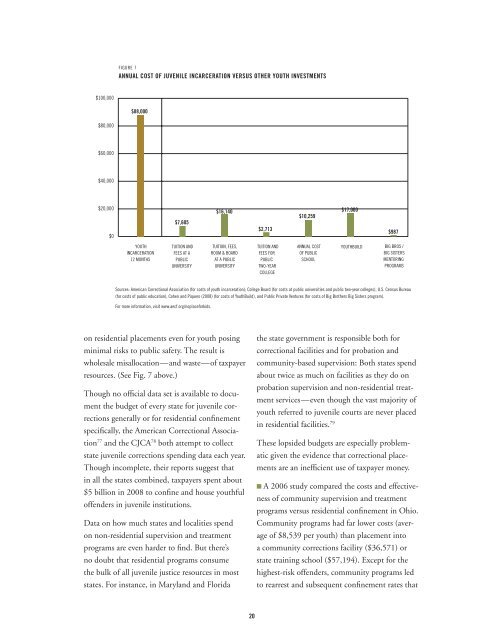aecf-NoPlaceForKidsFullReport-2011
aecf-NoPlaceForKidsFullReport-2011
aecf-NoPlaceForKidsFullReport-2011
You also want an ePaper? Increase the reach of your titles
YUMPU automatically turns print PDFs into web optimized ePapers that Google loves.
FIGURE 7ANNUAL COST OF JUVENILE INCARCERATION VERSUS OTHER YOUTH INVESTMENTS$100,000$88,000$80,000$60,000$40,000$20,000$0$7,605$16,140$2,713$10,259$17,000$987YOUTHINCARCERATION12 MONTHSTUITION ANDFEES AT APUBLICUNIVERSITYTUITION, FEES,ROOM & BOARDAT A PUBLICUNIVERSITYTUITION ANDFEES FORPUBLICTWO-YEARCOLLEGEANNUAL COSTOF PUBLICSCHOOLYOUTHBUILD BIG BROS /BIG SISTERSMENTORINGPROGRAMSSources: American Correctional Association (for costs of youth incarceration); College Board (for costs at public universities and public two-year colleges), U.S. Census Bureau(for costs of public education), Cohen and Piquero (2008) (for costs of YouthBuild), and Public Private Ventures (for costs of Big Brothers Big Sisters program).For more information, visit www.<strong>aecf</strong>.org/noplaceforkids.on residential placements even for youth posingminimal risks to public safety. The result iswholesale misallocation—and waste—of taxpayerresources. (See Fig. 7 above.)Though no official data set is available to documentthe budget of every state for juvenile correctionsgenerally or for residential confinementspecifically, the American Correctional Association77 and the CJCA 78 both attempt to collectstate juvenile corrections spending data each year.Though incomplete, their reports suggest thatin all the states combined, taxpayers spent about$5 billion in 2008 to confine and house youthfuloffenders in juvenile institutions.Data on how much states and localities spendon non-residential supervision and treatmentprograms are even harder to find. But there’sno doubt that residential programs consumethe bulk of all juvenile justice resources in moststates. For instance, in Maryland and Floridathe state government is responsible both forcorrectional facilities and for probation andcommunity-based supervision: Both states spendabout twice as much on facilities as they do onprobation supervision and non-residential treatmentservices—even though the vast majority ofyouth referred to juvenile courts are never placedin residential facilities. 79These lopsided budgets are especially problematicgiven the evidence that correctional placementsare an inefficient use of taxpayer money.n A 2006 study compared the costs and effectivenessof community supervision and treatmentprograms versus residential confinement in Ohio.Community programs had far lower costs (averageof $8,539 per youth) than placement intoa community corrections facility ($36,571) orstate training school ($57,194). Except for thehighest-risk offenders, community programs ledto rearrest and subsequent confinement rates that20



